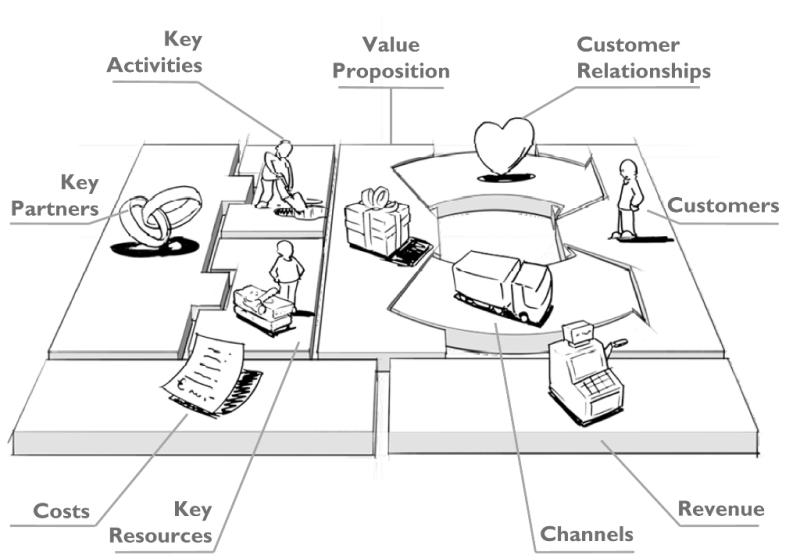Meeting 5
From 2012e.igem.org
(→Porter’s Forces:) |
|||
| (13 intermediate revisions not shown) | |||
| Line 11: | Line 11: | ||
! width="100 px" style="background:SteelBlue; color:Black"|[[Metting 4]] | ! width="100 px" style="background:SteelBlue; color:Black"|[[Metting 4]] | ||
! width="100 px" style="background:SteelBlue; color:Black"|[[Meeting 5]] | ! width="100 px" style="background:SteelBlue; color:Black"|[[Meeting 5]] | ||
| + | ! width="100 px" style="background:SteelBlue; color:Black"|[[Meeting 6]] | ||
|} | |} | ||
<div align="center"> | <div align="center"> | ||
| + | |||
| + | :'''Meeting 5''' | ||
| + | <br> | ||
| + | <h3>Defining Our Model</h3> | ||
| + | <br> | ||
| + | <div align="justify"> | ||
| + | |||
| + | Business Model Generation written by Alexander Osterwalder and Yves Pigneur, was our key to develop and understand business models. We guided and conducted our proyect based on the following canvas. It contains the basic structures that compose a business model. You can find more about our development in the Business Model section. | ||
| + | |||
<div align="center"> | <div align="center"> | ||
| - | |||
| - | < | + | [[File:bmc.jpg]] |
| + | |||
| + | <div align="justify"> | ||
| + | |||
| + | |||
| + | |||
| + | =='''Porter’s Forces:'''== | ||
| + | |||
| + | |||
| + | To strengthen our model we decided to evaluate other points of view, in order to do this we studied the publication “The Five Competitive Forces That Shape Strategy” by Michael E. Porter, Harvard Business Review. Determining these five forces can help a company understand the structure of its industry and stake out a position that is more profitable and less vulnerable to attack. Adapting this to our business, we identified them as follows: | ||
| + | |||
| + | 1. Clients: Any company dedicated to industrial activities and manufacturers that generate sub products that are not being used and may represent a potential asset, also any industry that needs to optimize and improve the basic techniques used for their operations or solve problems associated with these operations. | ||
| + | |||
| + | 2. Suppliers: http://syntheticbiology.org/Industry.html (DNA2.0) Universities and research centers that have developed any DNA sequences we could need for our clients. We could make the design and build it somewhere specialized for example companies that synthesize DNA. | ||
| + | |||
| + | 3. Potential Threats: We don’t know an enterprise planning to come to our region and offer this type of services but we do know some companies that are in the synbio industry. We should make a list of companies that could be interested in this type of services. | ||
| + | |||
| + | 4. Substitute Services: the company could choose to hire their our personnel to manage the area (In a longterm it will be more expensive) | ||
| + | 5. Competition: right know any other company offers this service in our region. | ||
| - | + | As a future approach: Consultancy to optimize industrial processes using Synthetic Biology as a tool, mainly by exploiting sub products and offering a channel so that our suppliers are able to reach the clients. | |
Latest revision as of 22:04, 27 October 2012
|
Home |
Defining Our Model
Business Model Generation written by Alexander Osterwalder and Yves Pigneur, was our key to develop and understand business models. We guided and conducted our proyect based on the following canvas. It contains the basic structures that compose a business model. You can find more about our development in the Business Model section.
Porter’s Forces:To strengthen our model we decided to evaluate other points of view, in order to do this we studied the publication “The Five Competitive Forces That Shape Strategy” by Michael E. Porter, Harvard Business Review. Determining these five forces can help a company understand the structure of its industry and stake out a position that is more profitable and less vulnerable to attack. Adapting this to our business, we identified them as follows: 1. Clients: Any company dedicated to industrial activities and manufacturers that generate sub products that are not being used and may represent a potential asset, also any industry that needs to optimize and improve the basic techniques used for their operations or solve problems associated with these operations. 2. Suppliers: http://syntheticbiology.org/Industry.html (DNA2.0) Universities and research centers that have developed any DNA sequences we could need for our clients. We could make the design and build it somewhere specialized for example companies that synthesize DNA. 3. Potential Threats: We don’t know an enterprise planning to come to our region and offer this type of services but we do know some companies that are in the synbio industry. We should make a list of companies that could be interested in this type of services. 4. Substitute Services: the company could choose to hire their our personnel to manage the area (In a longterm it will be more expensive) 5. Competition: right know any other company offers this service in our region. As a future approach: Consultancy to optimize industrial processes using Synthetic Biology as a tool, mainly by exploiting sub products and offering a channel so that our suppliers are able to reach the clients.
|
 "
"

